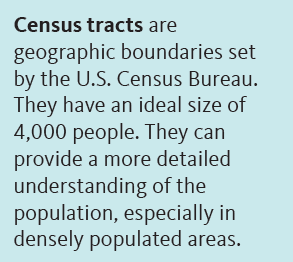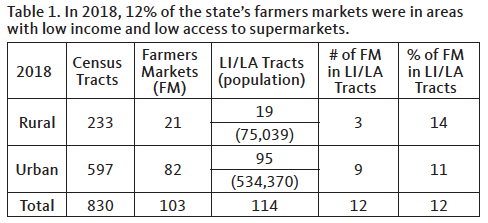Growing Farms Online Course: Learn how to start a successful sustainable small farm.
Developed by OSU Small Farms Program faculty and other farm management experts, you will learn the essentials of designing and growing your own thriving farm business. And the entire program is available online, so you can complete it on your time, around your schedule. Turn your dream of owning and operating a small farm or ranch into a successful reality with this popular program!
Oregon Community Food Systems by the Numbers
12% of Oregon’s farmers markets are in areas with low income and low access to supermarkets
Around the U.S. and in Oregon, people and organizations traditionally involved with separate elements of the food system are coming together to tackle challenges related to health, environment, and the economy, as part of the “community food systems” movement. Bringing people and organizations together to evaluate and change aspects of the food system requires developing a common understanding of issues and shared goals. The Community Food Systems Indicators provide an integrated dataset that supports these efforts.
Access to food in Oregon
People need access to healthy and affordable food. Access can be measured in many different ways; the USDA creates the low-income and low-access measure (LI/LA) by census tract, using income and distance to supermarkets. This information is used by governments, community planners, public health officials, and researchers to plan programs and target resources that increase access and improve diets and health.
While supermarkets are the primary way many people access food, the number of farmers markets has increased, which can provide important access to some food items. Nutrition and public health researchers have suggested that farmers markets and other direct-to-consumer venues can increase healthy food access in rural communities (see “For more information,” Johnson et al.). We examined 2018 data for Oregon to see if farmers markets currently fill some of the gaps left by supermarkets.
Do farmers markets fill the gap when supermarkets are too far away?
Maybe. Many parts of Oregon do not have a farmers market. There are 12 LI/LA areas with a farmers market and most of these are in urban areas (see Table 1). Farmers markets are organized for a variety of reasons and meet multiple needs, such as the Lents International Farmers Market in Portland that was founded to improve food access.
- A higher share of the state’s urban population lives in an LI/LA area: 18% compared to 14% of the nation’s urban population.
- In both Oregon and the U.S., 8% of the rural population lives in an LI/LA area.
- There are farmers markets in 10.5% of Oregon’s LI/LA areas.
- Almost 80% of farmers markets in Oregon and 88% of Oregon’s population living in an LI/LA area are in urban census tracts.
We can also visually examine the distribution of low income and low access to supermarket census tracts with the known locations of some of the farmers markets across the state (see Figure 1).
Efforts to expand access to fresh, healthy foods are important statwide. Farmers markets may offer one opportunity to increase access, especially in areas with the lowest access to supermarkets. Other factors to consider include the suitability of the area for local food production and the density, ability to travel, and spending capacity of the area’s population.
What else matters?
- Does the presence of a farmers market have a significant effect on the level of food availability within an LI/LA area?
- How can farmers markets increase access to food statewide?
- Are there unique ways to support farmers market vendors and consumer access in LI/LA areas?
Data sources and definitions
This analysis uses data from the USDA ERS Food Access Research Atlas to visualize low-income census tracts with low access to supermarkets* and how, in 2018, these overlap with the distribution of farmers markets that are members of the Oregon Farmers Markets Association (OFMA). Not all farmers markets are members of OFMA. The Rural Communities Explorer website uses a different data source, the USDA’s Farmers Markets directory, which lists an additional 65 markets, or 168 in total. However, many of these markets are no longer open. We use the OFMA list to focus on markets that are currently in operation.
Census tracts are designated as low income and low access (LI/LA) following these definitions:
- Low income (LI)
– Proportion of the population based on poverty rate or median household income compared to the state or metropolitan area
- Low access (LA)
– Households that are more than ½ mile from the nearest supermarket and have no access to a vehicle; or
– Households that live more than 20 miles from the nearest supermarket regardless of vehicle access
About 14% of Oregon’s census tracts are considered LI/LA under this definition, while 30% of Oregon’s census tracts are considered LI/LA under another definition*.
For more information
Johnson, D.B., E. Quinn, M. Sitaker, A. Ammerman, C. Byker, W. Dean, S. Fleischhacker, J. Kolodinsky, C. Pinard, S.B. Jilcotta Pitts, and J. Sharkey (2014.) “Developing an agenda for research about policies to improve access to healthy foods in rural communities: a concept mapping study.” BMC Public Health 14: 592–603. https://doi.org/10.1186/1471-2458-14-592
USDA ERS Food Access Research Atlas https://www.ers.usda.gov/data-products/food-access-research-atlas/
A recent study examined changes to the number of LI/LA areas nationally: https://www.ers.usda.gov/amber-waves/2017/april/low-income-areas-with-low-supermarket-access-increased-in-urban-areas-but-not-in-rural-areas-between-2010-and-2015/
For more analysis and resources on Community Food Systems, visit OSU’s Small Farms Program online. Knowledgeable faculty are available statewide: http://centerforsmallfarms.oregonstate.edu/
To access data on your community and food systems visit the Rural Communities Explorer: http://oe.oregonexplorer.info/rural/CommunitiesReporter/
© 2018 Oregon State University.
Extension work is a cooperative program of Oregon State University, the U.S. Department of Agriculture, and Oregon counties. Oregon State University Extension Service offers educational programs, activities, and materials without discrimination on the basis of race, color, national origin, religion, sex, gender identity (including gender expression), sexual orientation, disability, age, marital status, familial/parental status, income derived from a public assistance program, political beliefs, genetic information, veteran’s status, reprisal or retaliation for prior civil rights activity. (Not all prohibited bases apply to all programs.) Oregon State University Extension Service is an AA/EOE/Veterans/Disabled.





